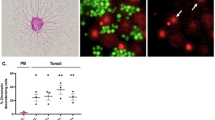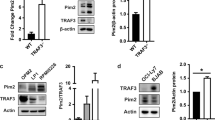Abstract
Approximately 65% of B cells generated in human bone marrow are potentially harmful autoreactive B cells1. Most of these cells are clonally deleted in the bone marrow, while those autoreactive B cells that escape to the periphery are anergized or perish before becoming mature B cells2,3,4,5. Escape of self-reactive B cells from tolerance permits production of pathogenic auto-antibodies6; recent studies suggest that extended B lymphocyte survival is a cause of autoimmune disease in mice and humans7. Here we report a mechanism for the regulation of peripheral B-cell survival by serine/threonine protein kinase Cδ (PKCδ): spontaneous death of resting B cells is regulated by nuclear localization of PKCδ that contributes to phosphorylation of histone H2B at serine 14 (S14-H2B). We show that treatment of B cells with the potent B-cell survival factor BAFF (‘B-cell-activating factor belonging to the TNF family’) prevents nuclear accumulation of PKCδ. Our data suggest the existence of a previously unknown BAFF-induced and PKCδ-mediated nuclear signalling pathway which regulates B-cell survival.
This is a preview of subscription content, access via your institution
Access options
Subscribe to this journal
Receive 51 print issues and online access
$199.00 per year
only $3.90 per issue
Buy this article
- Purchase on Springer Link
- Instant access to full article PDF
Prices may be subject to local taxes which are calculated during checkout




Similar content being viewed by others
References
Wardemann, H. et al. Predominant autoantibody production by early human B cell precursors. Science 301, 1374–1377 (2003)
Goodnow, C. C. et al. Altered immunoglobulin expression and functional silencing of self-reactive B lymphocytes in transgenic mice. Nature 334, 676–682 (1988)
Nemazee, D. A. & Burki, K. Clonal deletion of B lymphocytes in a transgenic mouse bearing anti-MHC class I antibody genes. Nature 337, 562–566 (1989)
Erikson, J. et al. Expression of anti-DNA immunoglobulin transgenes in non-autoimmune mice. Nature 349, 331–334 (1991)
Hartley, S. B. et al. Elimination from peripheral lymphoid tissues of self-reactive B lymphocytes recognizing membrane-bound antigens. Nature 353, 765–769 (1991)
Goodnow, C. C. Balancing immunity and tolerance: deleting and tuning lymphocyte repertoires. Proc. Natl Acad. Sci. USA 93, 2264–2271 (1996)
Mackay, F. & Kalled, S. L. TNF ligands and receptors in autoimmunity: an update. Curr. Opin. Immunol. 14, 783–790 (2002)
Mackay, F. et al. Mice transgenic for BAFF develop lymphocytic disorders along with autoimmune manifestations. J. Exp. Med. 190, 1697–1710 (1999)
Gross, J. A. et al. TACI and BCMA are receptors for a TNF homologue implicated in B-cell autoimmune disease. Nature 404, 995–999 (2000)
Khare, S. D. et al. Severe B cell hyperplasia and autoimmune disease in TALL-1 transgenic mice. Proc. Natl Acad. Sci. USA 97, 3370–3375 (2000)
Mecklenbräuker, I., Saijo, K., Zheng, N. Y., Leitges, M. & Tarakhovsky, A. Protein kinase Cδ controls self-antigen-induced B-cell tolerance. Nature 416, 860–865 (2002)
Pelletier, M. et al. Comparison of soluble decoy IgG fusion proteins of BAFF-R and BCMA as antagonists for BAFF. J. Biol. Chem. 278, 33127–33133 (2003)
Thompson, J. S. et al. BAFF-R, a newly identified TNF receptor that specifically interacts with BAFF. Science 293, 2108–2111 (2001)
Yan, M. et al. Identification of a novel receptor for B lymphocyte stimulator that is mutated in a mouse strain with severe B cell deficiency. Curr. Biol. 11, 1547–1552 (2001)
Khan, W. N. et al. Defective B cell development and function in Btk-deficient mice. Immunity 3, 283–299 (1995)
Woodland, R. T., Schmidt, M. R., Korsmeyer, S. J. & Gravel, K. A. Regulation of B cell survival in xid mice by the proto-oncogene bcl-2. J. Immunol. 156, 2143–2154 (1996)
Claudio, E., Brown, K., Park, S., Wang, H. & Siebenlist, U. BAFF-induced NEMO-independent processing of NF-κB2 in maturing B cells. Nature Immunol. 3, 958–965 (2002)
Kayagaki, N. et al. BAFF/BLyS receptor 3 binds the B cell survival factor BAFF ligand through a discrete surface loop and promotes processing of NF-κB2. Immunity 17, 515–524 (2002)
Mischak, H. et al. Overexpression of protein kinase C-δ and -ɛ in NIH3T3 cells induces opposite effects on growth, morphology, anchorage dependence, and tumorigenicity. J. Biol. Chem. 268, 6090–6096 (1993)
Emoto, Y. et al. Proteolytic activation of protein kinase C δ by an ICE-like protease in apoptotic cells. EMBO J. 14, 6148–6156 (1995)
Ghayur, T. et al. Proteolytic activation of protein kinase C δ by an ICE/CED 3-like protease induces characteristics of apoptosis. J. Exp. Med. 184, 2399–2404 (1996)
DeVries, T. A., Neville, M. C. & Reyland, M. E. Nuclear import of PKCδ is required for apoptosis: identification of a novel nuclear import sequence. EMBO J. 21, 6050–6060 (2002)
Reyland, M. E., Anderson, S. M., Matassa, A. A., Barzen, K. A. & Quissell, D. O. Protein kinase C δ is essential for etoposide-induced apoptosis in salivary gland acinar cells. J. Biol. Chem. 274, 19115–19123 (1999)
Ajiro, K. Histone H2B phosphorylation in mammalian apoptotic cells. An association with DNA fragmentation. J. Biol. Chem. 275, 439–443 (2000)
Cheung, W. L. et al. Apoptotic phosphorylation of histone H2B is mediated by mammalian sterile twenty kinase. Cell 113, 507–517 (2003)
Fernandez-Capetillo, O., Allis, C. D. & Nussenzweig, A. Phosphorylation of histone H2B at DNA double-strand breaks. J. Exp. Med. 199, 1671–1677 (2004)
Su, I. H. et al. Ezh2 controls B cell development through histone H3 methylation and Igh rearrangement. Nature Immunol. 4, 124–131 (2003)
Van Parijs, L. et al. Uncoupling IL-2 signals that regulate T cell proliferation, survival, and Fas-mediated activation-induced cell death. Immunity 11, 281–288 (1999)
Karpusas, M. et al. Crystal structure of extracellular human BAFF, a TNF family member that stimulates B lymphocytes. J. Mol. Biol. 315, 1145–1154 (2002)
Saijo, K. et al. Protein kinase Cβ controls nuclear factor κB activation in B cells through selective regulation of the IκB kinase α. J. Exp. Med. 195, 1647–1652 (2002)
Acknowledgements
We thank S. H. Ahn, D. Allis, M. Reyland, U. Siebenlist, the Rockefeller University Genotyping Resource Center and the MSKCC Genomics Core Laboratory for providing cells, vectors, reagents and technical assistance. We also thank E. Besmer for help with manuscript preparation, and A. Patke and members of the Tarakhovsky laboratory for discussions. This work was supported by The Irene Diamond Fund/Professorship Program (A.T.), the NIH (A.T.) and The S.L.E. Foundation (I.M.).
Author information
Authors and Affiliations
Corresponding author
Ethics declarations
Competing interests
The authors declare that they have no competing financial interests.
Supplementary information
Supplementary Figure 1
PKCδ does not control the expression of BAFF and its receptor. (PDF 18 kb)
Supplementary Figure 2
PKCδ does neither control the expression of IL-6 mRNA, secretion of IL-6 nor IL-6-dependent survival of peripheral B cells. (PDF 23 kb)
Supplementary Figure 3
3PKCδ does not control the expression of mRNAs encoding anti- or pro-apoptotic proteins in peripheral B cells and PKCd-deficient cells remain sensitive to BAFF. (PDF 112 kb)
Supplementary Table 1
Mouse microsatellite polymorphic sites used for genotyping of PKCδ-/- mice on C57BL/6 genetic background. (DOC 108 kb)
Rights and permissions
About this article
Cite this article
Mecklenbräuker, I., Kalled, S., Leitges, M. et al. Regulation of B-cell survival by BAFF-dependent PKCδ-mediated nuclear signalling. Nature 431, 456–461 (2004). https://doi.org/10.1038/nature02955
Received:
Accepted:
Published:
Issue Date:
DOI: https://doi.org/10.1038/nature02955
This article is cited by
-
BAFF-driven NLRP3 inflammasome activation in B cells
Cell Death & Disease (2020)
-
Protein Kinase C δ: a Gatekeeper of Immune Homeostasis
Journal of Clinical Immunology (2016)
-
N-benzyladriamycin-14-valerate (AD 198) exhibits potent anti-tumor activity on TRAF3-deficient mouse B lymphoma and human multiple myeloma
BMC Cancer (2013)
-
Proteolytic activation of proapoptotic kinase protein kinase Cδ by tumor necrosis factor α death receptor signaling in dopaminergic neurons during neuroinflammation
Journal of Neuroinflammation (2012)
-
STIM1, PKC-δ and RasGRP set a threshold for proapoptotic Erk signaling during B cell development
Nature Immunology (2011)
Comments
By submitting a comment you agree to abide by our Terms and Community Guidelines. If you find something abusive or that does not comply with our terms or guidelines please flag it as inappropriate.



